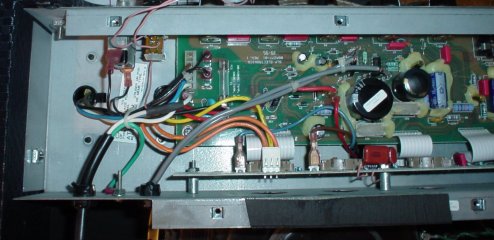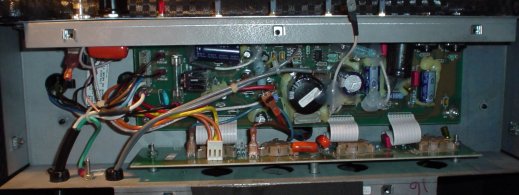The "Low-Watt" Power Control Project |
Last Updated 01/3/2004 |
The goal of this project is to modify existing amps, or design new amps, that permit control of the output power level independent of the amount of distortion. That is, we wish to have a single amplifier that will distort sweetly at high volume levels and at low volume levels.
The first step, modification of an Ampeg Jet J-12T: As a first step, on 22 and 23 June, 2002, I modified my Ampeg J-12T to permit zero to full power control of the output stage independent of the rest of the amp. The concept (using a high-power MOSFET as a voltage follower to control B+ to the output stage) proved very practical, but this prototype also pointed up several weaknesses requiring further consideration.
- The lower the output power, the more quickly the power stage gets driven into distortion. This isn't at all surprising and is, in fact, exactly what I expected. However, this has a drawback on an amp without a master volume (I had pulled my earlier master volume modification out of this amp to make room for the power control). Without a master volume it is impossible to come anywhere near saturating the preamp before driving the power amp into very heavy distortion at low volumes. Since the sweetest distortion comes from driving each stage of the preamp until it is just compressing, and then overdriving the output stage only lightly, it is obvious that this modification isn't of much use on an amp without a master volume control.
- Again at conversational output levels, the power amp distortion is a bit rougher than at higher power levels. Again, this isn't something that's a complete surprise as I half expected to need to at least lower the cathode resistor at very low voltage levels and perhaps to use matched tubes. But, I had to hear it for myself.
- Even in this little fifteen watt amp the MOSFET can end up dissipating somewhere around 30 watts in the worst case (i.e. when the voltage is dropped to the lowest point where the tubes are still drawing full current). I'm using a MOSFET rated at 125 watts, but on my first crack at this I mounted the MOSFET and an extruded heatsink to the circuit board inside the chassis. NOT a good idea. At worst case power levels the heatsink very quickly becomes too hot to touch. The MOSFET might survive, but dumping that much heat inside the chassis is NOT a good plan. I moved the MOSFET to heatsink against the chassis itself, with the extruded heatsink on the outside of the chassis, and that looks like it will work better.
- For some reason I haven't completely figured out yet, my modification jumped the 320V power supply (input to the voltage follower) up to a bit over 350V. Thus, if you crank the output control all the way up you're putting about 30 more volts on the plates than the original design. This amp is already designed right on the edge of being too hot for the EL84s, so guess who cooked an output tube! This is still boggling my mind a bit, as it doesn't seem possible since the voltage follower always drops a little voltage. I wish I had taken some voltage readings before starting, instead of assuming that the test point values on the schematic were accurate. It may well be that this amp was ready to cook a tube anyway, and that handling the tube just put it over the top. I know I blew one set of tubes and screen resistors in this amp when it was almost new, just by cranking the volume all the way up for a few minutes.
- Modifying modern amps that use printed circuit boards is a royal pain in the backside. In the future, I will either homebrew amps from scratch or I will build the entire modification into a "piggyback" chassis and run only wires to the circuit boards.
- After putting my Matchless-style "master volume" control back in, this turned out to be a pretty nice little project. There are still some problems. At very low output levels the dynamic range is very low – this is great for playing slide as it sustains forever but is not so good for some other styles of playing.


What do you mean the warranty is void?!
|